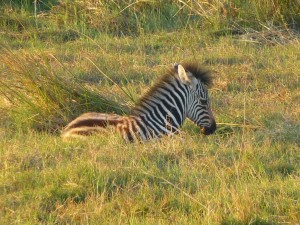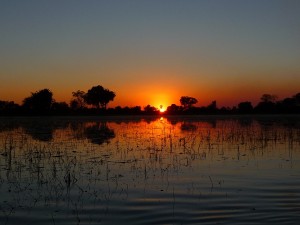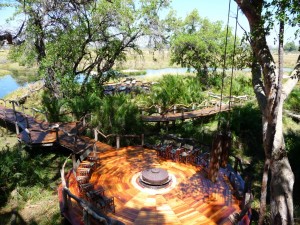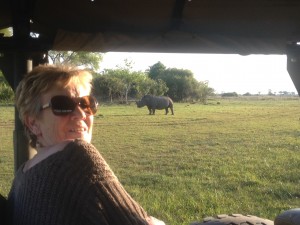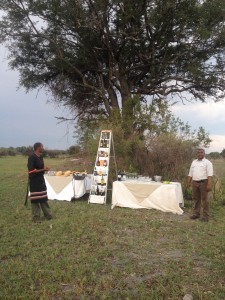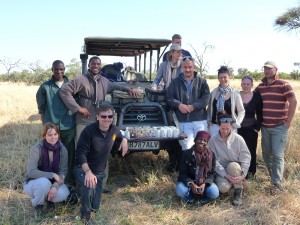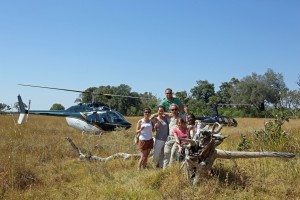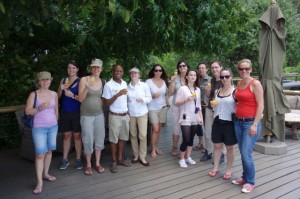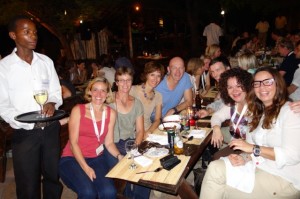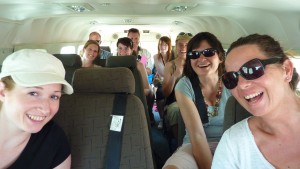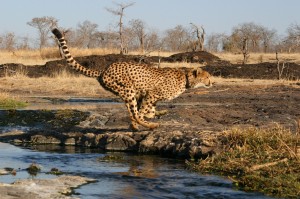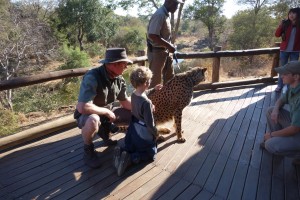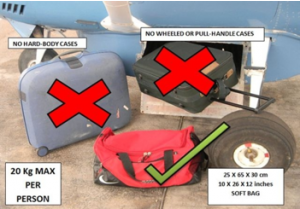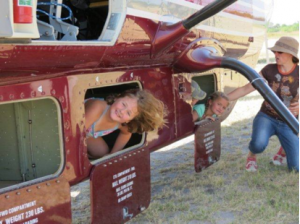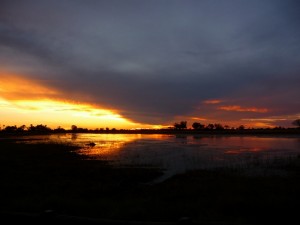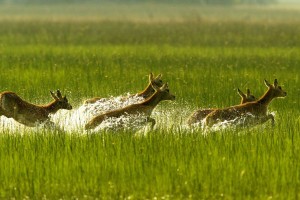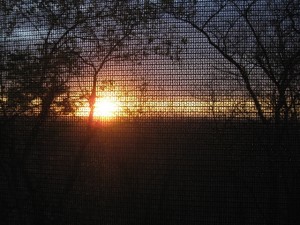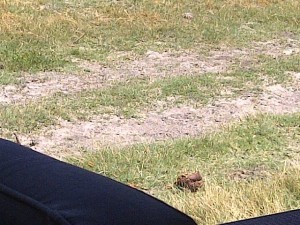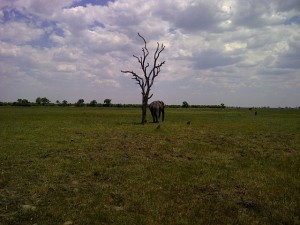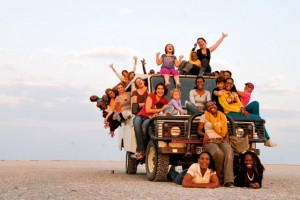Our visit to the Jao Concession in the Okavango Delta
In November Muriel and I had the opportunity to explore the camps in the Jao Concession, we visited Tubu, Little Tubu, Jao, Jacana and the new Pelo Camp. I am happy to share our experience with you:
Kwetsani: Spectacular setting over the lagoon, very ‘high and elevated camp’ everything is about views, large public deck, many different, intimate corners and tasteful spaces for the clients to withdraw and enjoy the scenery.
Units: due to their height they almost appear as ‘tree houses’, they will be enlarged and refurbished in the coming weeks, then the camp will be certainly my favorite of the classic collection in Jao.
Management: very passionate, open minded, outgoing, and certainly top service orientated camp manager, Charmaine.
Pelo Camp (pronounce PILU for all Setswana ignorants amongst us, as otherwise it sounds like kidney and not like heart, which is the shape of the island it is on).
New camp only open in high (=dry) season, very romantic, hidden in the thick bush on the island, pure water bases, the only activity is mokoro, so it will make a perfect last to relax in some horizontal safari (the birds’ concert is outstandingly entertaining) and concentrate on the small stuff.
The fire place with the bar is the central meeting point, elevated above the lagoon it offers views combined with a warm camp atmosphere.
The public area is a small tent with a terrace, true to the modest style, no big furniture but cushions to lounge.
The dining area is in another small tent, just enough to make clients feels safe without taking the camping feel away.
Units: from the outside it could be just a notch above mobile safari, they almost hide their luxurious interior (top comfy beds, perfect illumination, desk), which gives the camp the charisma of cozy, tented, intimate. Only outside bucket shower (in the cold winter months of June/July people should be informed/warned).
Food: great brunch, a variety a light and tasteful salads, beef sausages, cold pasta, cooked breakfast, fruit and cheeses. Dinner consisted of a veggie soup, excellent Impala stew, veggies and again salad, very pleasant.
Activities: mokoro, the nicest cruise I have ever done for over 2 hrs, safe, hippo free, and in a very lovely surrounding, apart from birder’s paradise, with hundreds of lechwe and elephant herds at our sights, we even spotted some shy Sitatunga.
Apart from mokoro, the manager takes clients to his very special Delta Pool for a refreshing swim and pick nick on the sand banks. Also catch+release fishing is possible.
Camp Jao: Just stunning, the jewel of the concession for the pampered, the Balinese palace in the Delta. All emphasis on luxury, spa, food, wine tasting, a perfect end or relaxing start to a safari, I could certainly stay for 5 days in this camp. The whole camp is highly elevated in beautiful old trees, as if the camp was a colony of tree houses connected by swaying boardwalks.
Apart from the spa, there is a proper gym, yoga mats and pilates balls, and a wine tasting parlour, as the unusual features.
Units: the best feature (vs its sisters in luxury Kings Pool/Vumbura Plains) is the shape of the rooms, as they are not deep but long, so from any point of the unit the views over the lagoon can be enjoyed, they are airy and full of light, which takes the weight off the massive wooden furniture and gives it a noble and highly elegant feel.
The public areas are impressive, two pools, one family one adults only plunge pool bordering with the Delta, large shady sitting areas on a 10 m tall deck. The impressive fireplace with unique Balinese drums builds the center of the camp with incredible views over the lagoon and its wildlife, e.g. Lechwe hunting Lions.
Kay’s visit to Chiefs Camp
Passionate about sharing our Experience…..
Every year we organise numerous educationals for our agents. This year was a record year, Lorraine, Clare and I counted and counted and we think we had over 80 agents travelling around Botswana, Zambia & Zimbabwe on educational visits. Most trips were individually tailor-made trips, based on the needs of the agents. Around Indaba we had 20 agents on safari, one group in Botswana and one in Zimbabwe.
This year one highlight followed the next. Recently Botswana Tourism organized the first “Botswana Tourism and Travel Expo” in Kasane. We were honoured to be part of it. It was hugely successful as it hosted 81 Tour Operators from Germany, Switzerland, Austria, Italy, France and Belgium. These 81 agents were split into various pre- and post-Expo educationals of 4 – 5 nights each. Safari Destinations partnered with Bush Ways Safaris and with Great Plains Conservation and put together three trips.
We always try to show our agents the beauty of the different regions as well as the different products on offer. Last week’s agents’ safaris included nights at Selinda Camp, Ghoha Hills Camp, camping with Bush Ways Safaris in Savuti, camping with Letaka Safaris in Khwai, both Sango Safari Camp and Machaba Camp in Khwai and a visits to Meno a Kwena Tented Camp on the Boteti River & Jacks Camp on the Makgadikgadi Salt Pans. The agents enjoyed site inspections of three lodges in Chobe (Chobe Elephant Camp, Ngoma Safari Lodge and Chobe Game Lodge) and brunch at Zarafa Camp and Savuti Safari Lodge. They experienced game drives, night drives and a walk with San Bushmen at Meno a Kwena.
Sylvester – the cheetah ambassador
Last weekend we spent a few days in Vic Falls and were excited to meet the famous cheetah Sylvester, who lives in the private concession of “The Elephant Camp” a few kilometers outside of Victoria Falls in Zimbabwe.
Here is his story:
In April 2010, in the Lowveld area of Zimbabwe, a cheetah gave birth to five cubs. Sadly within two days, in a cruel act of nature, she and four of her cubs were fatally attacked by a male lion, something which is common between apex predators in the wild. The sole survivor was discovered by a game scout named Sylvester, who witnessed the event and the cub was named after him by Norman and Penny English who became his surrogate parents. Norman worked in National Parks and Wildlife Management for many years and now heads the anti poaching unit in the Bubi Conservancy. Penny is a registered nurse and having both their experience was invaluable in the attempt to keep this young cheetah alive. At two days old, Sylvester still had his umbilical cord attached and unopened eyes.
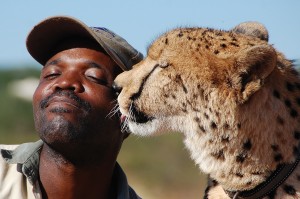
Sylvester is an orphaned cheetah who found a home in the private concession of The Elephant Camp in Victoria Falls, Zimbabwe
Over the following six months the hard work and devotion from the English
family was rewarded but it did not come easily. Feeding was complicated and
Sylvester grew faster than his bones could grow but the struggle to find a
suitable formula was assisted by the many cheetah experts who passed on
information. In time a dietary plan that suited Sylvester was formulated and
he began to respond.
As Sylvester was never destined to become a pet, and being a specially
protected animal on the endangered species list, the Department of National
Parks and Wildlife Management have naturally been involved from the outset
with Sylvester’s welfare. A plan needed to be formulated for a future
permanent home for Sylvester, and in this regard VFWT became involved. Despite numerous release attempts, cheetah, apparently, do not survive in the wild without experiencing the maternal care of a mother for the initial twenty two months of their lives. The human imprints of upbringing in captivity are not conducive to a wild release with rehabilitated cheetah often coming into contact with human settlements and being seen as “problem” animals.
The Sanctuary that Vic Falls Wildlife Trust operates from has large areas of
open grasslands where a cheetah can exercise naturally and build up the
speed for which they are renowned. With no large predators around and the
support from his three carers who exercise him extensively and assist in
nurturing this orphan, Sylvester has settled in to his new life with
vigour. Through our educational programme, Sylvester interacts with
schoolchildren and guests who visit the Elephant Wallow during other
activities. He will become an “ambassador” cheetah, interacting with the
public to raise awareness of their peril as a species and the challenges
they face being on the endangered species list.
Here in the Victoria Falls region, cheetah are a rare sighting and whilst
VFWT respects that the ultimate aim is to promote the conservation of
wildlife and are merely custodians of this magnificent animal, funds need to
be raised for his upkeep. With feeding, exercise, care and constant
companionship, Sylvester has already adapted perfectly to his new
environment.
Guests at The Elephant Camp have the unique opportunity to experience Sylvester, learn about his endangered species and can support this good cause.
We at Safari Destinations would like to raise awareness for this very important project.
Find out more about Sylvester the cheetah on Facebook: http://www.facebook.com/pages/Sylvester-Cheetah-Ambassador/169927003078626
Luggage restrictions have several reasons…
All travellers visiting Botswana want to experience the beautiful, remote places they’ve seen in the TV documentaries. The real wilderness Botswana has to offer that they don’t have to share with lots of other tourists. A safari in the out-of-reach corners of Botswana is an exclusive experience with a catch 22 about it. To get to these areas there are no tarred roads. Aside from the lack of tarmac, the distances are too big or the camps are surrounded by too much water, sitting on islands that can’t be reached…which is exactly why travellers want to visit, to experience a wilderness inaccessible to mass tourism. As a result, travellers need to jump into a light aircraft and let the pilot fly them into the adventure, wilderness & luxury camps that dreams are made of.
Already the name “light aircraft” should give you the hint that we are not talking about an Airbus A380. For most air transfers charter companies use aircraft such as the Cessna 206 or Cessna 210 which can accommodate the pilot and around five passengers. If clients are really lucky they may fly in an Airvan which can transfer seven passengers and one pilot or possibly a Cessna Grand Caravan, which is as big as it gets, accommodating 13 passengers and the pilot. But that’s about it. Bigger aircraft would need to overcome a long brake path and can’t land on the short graded airstrips in the national parks and private concessions.
With small aircraft comes this issue of fitting both luggage and passengers into the plane. All aircraft has a baggage compartment where the pilot stores clients’ luggage during their flight, but these are small and limited, meaning bags need to flexible (not rigid) and packed economically in order to make the most of the space available.
Due to the small payload of these aircraft any other variations in the expected weight in the aircraft need to be factored in far in advance to avoid overloading and breeching safety regulations. This includes passengers weighing more than 100kgs.
While it may seem an insensitive topic to broach, charter companies calculate their payload and required fuel based on passengers weighing 100kgs or less. As a result, charter companies need to be aware if passengers weigh more than 100kgs so they can limit the total amount of passengers and baggage accordingly. The restrictions in loading aircraft that result from flying passengers over 100kgs requires charging for an additional seat to compensate for the inability to carry the standard amount of passengers and luggage as a result.
LUGGAGE RESTRICTIONS:
Luggage dimensions should not exceed 25cm (10 inches) wide, 30cm (12 inches) high and 62 cm (24 inches) long. Anything larger and the luggage will not fit. Baggage weight (including hand luggage) is limited to a maximum of 20kg. Luggage must be entirely soft-sided. Hard covered, rigid bags are exceptionally difficult to load and unload and will most likely be left behind.
SD TIP! Due to the cramped space in light aircraft luggage holds, we also recommend taking camera equipment and other valuable items as hand luggage during flights to prevent possible damage.
We know that restrictions are never pleasant but clients need to keep in mind that we advise them of these restrictions in advance so they can arrive prepared and enjoy smooth air transfers as a result. All rules exist to provide the maximum possible client safety and comfort on board.
We understand our clients’ needs and know it is often hard to pack light for such a long journey; however clients can be re-assured that camps in remote areas usually include laundry service in the nightly rate. Clients are welcome to use the laundry service to minimise their luggage and rest-assured that the animals in the bush don’t mind seeing the same shirt twice.
If clients can’t travel without excess luggage we offer to store the luggage at our office in Maun. The restriction however is that this only works if clients start and end their safari in Maun. If clients end their safari somewhere elsewhere we would need to send the luggage on (e.g. on a flight to Kasane) creating extra costs for clients who have already spent all their spare change on their trip of a lifetime in Botswana. If excess luggage storage is required, we need to know in advance so that we can make a plan prior to arrival and not during our short meet and greet with your clients at Maun airport. Please also keep in mind that if your clients are travelling through Johannesburg Airport multiple times, excess luggage can be stored there as well.
To all travel agents & tour operators out there, please brief your clients about luggage restrictions connected to bush flying prior to travel. You can save your clients a lot of hassle if they’re aware of what to expect and how they need to be prepared for their journey of their lifetime.
The Okavango Delta – some true insider information about the water levels
THE OKAVANGO DELTA
“Unfortunately there is not enough water in the Okavango Delta during the rainy season for boat excursions”
“The water levels of the Okavango Delta are the highest during dry season”
Have you also read one of those before and wondered?
The Okavango Delta is a very unique part of the world. Looking at a satellite image you can easily see a few blue lines meandering from the Angolan highlands all the way to Botswana, forming a magnificent river that spreads into an alluvial fan and then simply disappears. It creates an amazing oasis in the middle of the World’s biggest stretch of sand, the Kalahari, reaching from Congo to South Africa. Magic. But the true magic is in the timing of the flood!
Rainy season in the catchment area and around the Okavango usually begins in November, with the majority of rain falling in January and February. The local rainfall only contributes to between 2 and 25% of the delta waters, the majority of water is coming down from the Angolan highlands.
If we traveled with a little drop of water from the source of one of the main contributories, the Cubango and Cuito River in Angola, the start of our journey would be quite exciting, through the Angolan highlands and then down to Botswana, but even before we’d cross over the border we’d already travel at a rather leisurely pace simply due to the lack of gradient. It takes this little drop of water average 8-9 weeks to reach Botswana and the panhandle of the Okavango Delta. From here onwards the journey slows down even more: the Northern part of the Okavango is 250km away from the Thamalakane fault line – the delta’s Southern border – but there is only a difference of 50 meters in altitude! The main waters reach Botswana in April and start to spread throughout the alluvial fan slowly filling up the channels, backflows and floodplains, with the delta being at its fullest in July/August. From August onwards the water levels start going down again due to evapotranspiration now exceeding the input by rain waters. The driest period in the delta is in October and November, when food is scarce and animals are found around the remaining water sources and rivers. Many channels have dried up, avid birders can’t get enough of all the bird life gathering around fish traps as the water keeps receding and cars can be used where just a few months ago boats were necessary to get around. Just then the first rains fall again, the shades of brown start turning into shades of green once more, impala and other antilope drop their young and the cycle starts over – the Okavango becoming a place of plenty. The water levels in the heart of the delta though will only rise significantly once the rains have long gone.
So what does this mean for us selling the destination?
This region is highly dynamic. Each year presents a varying amount of flood water in winter and a varying amount of rain falls in summer. Being nature, this provides a certain amount of unpredictability and nobody knows what will happen from one year to the next.
A well rounded Botswana Safari consists of game drives in drier areas and also water activities, be it by boat or mokoro. Mekoro are ideal to travel over floodplains in shallow water, gliding through reeds, discovering the little hidden gems of the area. Once the floodplains have fallen dry it becomes difficult to offer mokoro excursions due to safety concerns in deeper waters of permanent channels and rivers. Even if those deeper waters are actually not that deep anymore, they are considered prime real estate amongst hippos in not that great a mood as their territories are shrinking with the receding water and they are now very much up close and personal with their competitor and neighbor….
It is far easier on the nerves to observe those dynamics from a motor boat, but be aware that cruises can be a lot shorter due to a lack of either depth or river altogether! Eagle Island Camp for example, a camp that often has been sold as typical water-based delta experience, may not be able to offer mokoro during very low flood levels. The camps shift their focus. The floodplains may not be ideal for mokoro anymore, but they provide wonderful grazing for herds of buffalo as around Duba Plains; around Jao Camp the floodplains fill up with big herds of lechwe, enjoying the greenery. Other camps might not be that heavily affected and still happily take their guests on mokoro excursions and motor boat activities.
Here in Maun the flood levels of the Okavango Delta are an everyday topic and we never get tired of it. When did “the wave” come past Nxamaseri, has the water already moved towards Vumbura, when will it reach Sandibe… There is no end to it!
The delta is a truly wild place, it is alive and offers mind-blowing experiences on land and water year round. For next year: Let’s just keep the waterlevels in mind and choose the camps that offer water-based activities wisely.
On Safari at Ghoha Hills Camp in Savuti
At the end of October I got the chance to see Ghoha Hills Camp which opened its doors in mid 2012. The most impressive selling point of this lodge is its location which boasts a magnificent view. The lodge lies on top of the hills it’s named for, overlooking the Ghoha area and a small waterhole. Ghoha Hills offers a brilliant compromise between other lodges based in the Savute & Linyanti areas because it lies between them. The design of the lodge is stunning with the light colour schemes and pale woods used, making a really fresh, modern & welcoming impression. Even being a grumpy morning person, I had to be impressed by the stunning sunrises, which I watched through my window in camp.
The smooth sunrises at Ghoha ensured I was happy and ready to start my days of game viewing. The lodge offers game drives on their own private road network, daytrips into Savute or if clients stay 3 or more nights, into Linyanti. The lodge offers some flexibility however and is willing to cater to the preferences of guests in camp for activities provided there’s enough interest. With the longer daytrips you also need to keep in mind that the transfer takes a while, because the lodge is situated a while from the Savute marsh. It’s a 45 minute drive from camp to the airstrip and further again to the Savute marsh, but it was worth bumping around in the car on the sandy roads.
During my time at Ghoha Hills I saw so many things: thousands of elephants & buffalos, huge herds of zebras, giraffes and my personal highlight, a cheetah feeding on an impala. We found the cheetah underneath a little bush but the moment I got the camera out of my bag and tried to take a photo it ran away and I was left with a nice shot of buffalo “poo” next to our car instead.
After I had overcome the big disappointment of my failed cheetah photograph I at last had the chance to get a nice photo of an elephant standing next to a dead tree, giving me a beautiful scenery shot and bringing the beauty of the area across. After spending a few days at Ghoha Hills, I was reminded how great the Savute area is and how much it is worth every visit. As Ghoha Hills is one of the few lodges with family units (they have two) and are willing to take kids from 6 years onwards, it’s also a great family choice.
Over all, Ghoha Hills offers very good value for money and a great safari experience which is why we’ve packaged it in our 10 night Northern Highlights Standard itinerary and 12 Night Family Safari.
Check out our agents’ corner for more information on Ghoha Hills and packages that include the camp and the Savuti area.
